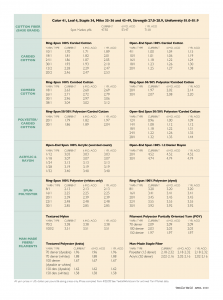 By Jim Phillips, Yarn Market Editor
By Jim Phillips, Yarn Market Editor
Many spinners are still working at least part-time schedules, despite the social distancing and shelter-in-place regulations mandated by some states and municipalities.
The level of business these spinners are experiencing depends largely on the types of yarns they are producing. “Obviously, there is tremendous demand for products that support the medical community and essential workers,” said one industry expert. “Those who have a presence in supplying the fabricators that make these types of products tend to be busier than others. Those who still dabble in commodity products are not likely quite so busy.”
Parkdale is one of those companies that has the resources to weather the current economic environment. The company has turned its considerable resources toward helping front-line medical worker stay safe while combatting the virus.
A Parkdale Mills subsidiary, U.S. Cotton has joined in an effort with the Food & Drug Administration (FDA), the Gates Foundation, UnitedHealth Group and Quantigen to ramp up production of spun synthetic swabs to help the country’s frontline health care workers who administer COVID-19 tests. U.S. Cotton has developed a fully synthetic, polyester-based Q-tip-type swab that can be used in coronavirus diagnostic testing. The U.S. Food and Drug Administration just announced that these synthetic swabs — with a design similar to Q-tips — could be used to test patients for the coronavirus.
A company release details how U.S. Cotton plans to leverage its large-scale manufacturing capacity to rapidly increase production of large quantities of the polyester swabs, which are in short supply for testing kits across the country.
The FDA has determined that spun synthetic swabs can be used in COVID-19 testing based on the results from a clinical investigation. John Nims, president of U.S. Cotton, said: “We stand ready to serve in this important fight and want to do all we can to help deploy these testing kit swabs for the American people. We greatly appreciate the collaborative efforts with the UnitedHealth Group, Quantigen, and the Gates Foundation to help support these necessary clinical studies to help advance this critically needed product to market.”
Companies Anticipate Post-Pandemic Boom
With few exceptions, the faces of the industry are turned hopefully to the post-pandemic future. “It seems almost certain that there will be a production boom,” said one executive. “With many manufacturers closed and others working reduced schedules, we anticipate there is going be very high demand for products after this is over.”
Added a business analyst who follows manufacturing: “From textiles to automotive, companies expect to have to scramble to keep pace with the demands of a newly invigorated economy — whenever that happens.” For some companies, however, the longer consumers are cautioned to stay at home, the poorer the prospects become for their long-term survival.
“Large companies — especially those that are multinational — have the resources to remain viable during this crisis and resume operations with only minimal-to-moderate damage to their businesses,” said a manufacturing consultant. “Smaller companies are likely to struggle much more, and many of them may not survive. This is not currently playing out to a large degree in the manufacturing sector, but many small companies in service industries — take Mom & Pop restaurants, for instance — are shutting doors forever. It becomes more and more obvious that, if we don’t get back to a stable economy relatively quickly, we are going to see the same thing happen to other sectors of the economy, especially manufacturing.”
Insights about the expected impact of COVID-19 on manufacturers have been derived from a number of recent studies. For example, a survey by the Institute for Supply Management (ISM) reveals that more than 80 percent of manufacturers say they believe their organizations will experience some impact because of COVID-19 disruptions. Of those, 16 percent have indicated they are adjusting revenue targets downward by an average of 5.6 percent.
“The story the data tells is that companies are faced with a lengthy recovery to normal operations in the wake of the virus outbreak,” Thomas W. Derry, CEO of ISM, said in a recent news release. “For a majority of U.S. businesses, lead times have doubled, and that shortage is compounded by the shortage of air and ocean freight options to move product — even if they can get orders filled.”
And, according to a recent survey by the National Association of Manufacturers, the COVID-19 pandemic has already impacted many manufacturers. About 80 percent of manufacturers who responded to that survey said they expect the pandemic to financially impact their businesses.
Manufacturers are vulnerable for two primary reasons: Many manufacturing jobs are on-site and cannot be carried out remotely, and the slowing economy is likely to reduce demand for industrial products. As a result, some manufacturers have temporarily suspended operations, and many are mulling through layoff strategies.
“Layoffs are sometimes necessary just to remain financially viable,” said one spinner. “But they are also something we have to consider very carefully. We already have some difficulty in attracting qualified job applicants, and the last thing we want to do is to lose skilled talent to other industries.”
As one analyst put it: “All-in-all, the sooner this is over, the better it will be for everyone. Just keep your fingers crossed.”
Raw material costs decline
As spinners struggle to manage in such a difficult environment, they are finding at least some financial respite from drastically reduced raw materials costs. The bottom has fallen out of the oil market, and the price of cotton has dropped precipitously over the past few weeks. For example, the price of Brent crude oil dropped to a two-decade low of $15.98 a barrel in trading on April 22. Compare that to the $46.92 price per barrel for the same oil in July 2016. Also, the price of base-quality cotton in the seven designated markets measured by the USDA fell to 47.55 cents for the week ended April 16. This compares to 72.61 cents for the same period a year ago. Demand for cotton was moderately lower from the same period a year ago, dropping from 27,298 spot transactions in late April 2018 to 22,698 this year.
April 2020





